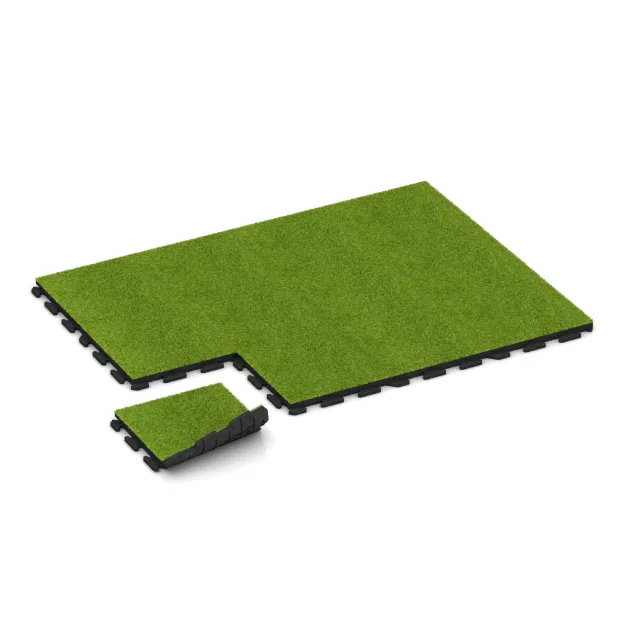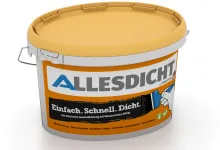Artificial grass decking tile 3 or 4 cm HZ "Green Artificial Grass"
- /
-
Delivery in approx.
3-4 weeks - €128.00 / 4 Piece / m²
- (7.38 kg / Piece)
EAN: 4251469313682 | Item no.: 1368
The artificial grass decking tile brings the look and feel of a green lawn directly to balconies, terraces, roof decks, loggias or covered seating areas. It combines a high-quality artificial turf surface with a robust rubber granulate base tile. With a handy 50×50 cm format and available in 3 or 4 cm thickness, it is suitable for both small balconies and larger roof areas.
Seamless lawn look. After installation and brushing the grass fibres upright, the surface appears uniform and seamless. The joints between the tiles disappear completely, leaving the impression of a continuous natural lawn.
Easy installation. The tiles are laid floating on any flat, load-bearing surface – with no glue or screws. A hidden all-round puzzle interlock in the rubber base connects the elements securely while remaining invisible.
Comfort & safety. The artificial turf surface feels pleasantly soft under bare feet. At the same time, the flooring is slip-resistant and ensures secure footing even when wet. The elastic structure reduces footstep noise, making the area quiet and comfortable. Furniture or planters can be placed without leaving permanent marks.
Low-maintenance & quick-drying. Fully water-permeable, the tiles dry quickly and prevent puddles from forming. Fine dirt is rinsed away naturally, while coarse dirt can be removed easily with a broom, vacuum or hose.
Weatherproof & durable. The artificial grass decking tile is frost- and weather-resistant and designed for long-term outdoor use. Any natural ageing of the materials remains minimal and does not affect functionality.
With its homely turf look, easy installation and robust properties, the artificial grass decking tile is the ideal solution for adding a green touch to balconies, terraces or roof areas.
Discount
Product Highlights
Characteristics
Product Details – Material and Structure
Comparative values
To calculate how many tiles you need for your project, simply use the online installation planner available in the shop. This free browser-based tool is directly accessible on each product page – just below the price and quantity selection. Click on “Plan installation” to open the tool instantly – no registration or download required.
Enter the dimensions of your area, such as the length and width in metres. The planner will then automatically calculate the total number of tiles required, including a realistic allowance for offcuts. You’ll also be shown a suitable layout pattern for the selected product. The tool is user-friendly, accurate and ideal for planning your material requirements with confidence.
Yes, that is the standard approach. The vast majority of our customers – whether private, municipal, or commercial – install the delivered WARCO tiles themselves or with their own staff. The installation is simple and requires no special skills. Only fitting the curb into a concrete foundation with back support demands a little extra craftsmanship. Cutting the elements to size and laying them on a suitable substrate is not challenging. You can find all essential installation information in our Expert Advice – FAQ section on our website.
WARCO offers several connection systems for floor tiles, each differing in design, installation method and visual appearance. Below is an overview of the key differences:
Puzzle joint (visible)
In this system, the tile edges feature an interlocking profile reminiscent of classic jigsaw teeth or mushroom-shaped connectors. During installation, the profiles of adjacent tiles interlock to form a continuous connection across the full tile thickness.
The joint profile may be formed directly during pressing or precisely cut after the tile has cured. Whether the joint is visible in the finished surface depends on the edge finish (e.g. with or without chamfer) and the surface colouration.
The symmetrical shape ensures uniform load transfer and makes this type of joint the most mechanically stable option.
Plug-in connectors (plastic dowels)
This system uses separate connecting elements, typically round plastic dowels, which are inserted into pre-drilled holes along the sides of the tiles. The tiles themselves have smooth, straight edges similar to precast concrete slabs.
Installation is carried out in a half-bond (stretcher bond) pattern: each tile is connected via dowels to two tiles in the row above and two in the row below. This prevents lateral shifting, although some movement along the length of the dowels remains possible. For this reason, an edge restraint must be installed around the perimeter to stabilise the entire area.
Concealed puzzle joint
This method is based on the same mechanical principle as the classic puzzle joint, but is designed to be invisible in the finished surface. The interlocking profile is located on the underside of the tile, integrated into a rebated step joint.
Two tile edges feature a positive locking profile, the other two a matching negative profile. When laid, the tiles interlock securely from below, forming a durable mechanical connection. From above, the surface appears seamless and aligned, typically with a clean, square joint pattern similar to a chessboard layout.
















